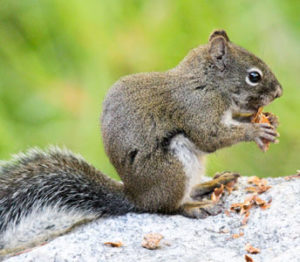
When your Denver mechanic excitedly says, “You’re not going to believe what we found!” and you live in Grand Lake, you know this isn’t going to be good. Our vehicle just didn’t have its usual oomph when climbing Berthoud Pass, so naturally I assumed it was time to replace the filters and spark plugs. Yes, it needed a tune-up, but what my old Highlander didn’t need was a friggin’ huge nest that has been there for who-knows-how-long packed tightly into the air filter box (fortunately, animal parts and babies were not present). A huge mass of dried grasses, twine from my drooping Christmas lights and cloth fragments from who knows where had been suffocating my car’s engine.
After a bit of research on the types of rodents that build humungous nests, I’ve sleuthed that the culprit was most probably a pine squirrel, also known as a chickaree. Here’s a description of the pine squirrel: “Like the Chihuahua who thinks it’s a pit bull, this squirrel thinks it’s a mountain lion.” It’s one of the most vocal animals in the forest. It chatters, stomps its feet, and if you’ve ever had the audacity to walk past a tree on your property, it scolds from its lofty perch for intruding in its territory. They are literally the sentries of the forest, alerting other animals of imminent danger.
Some tree squirrels work symbiotically by burying seeds to propagate new forests. This one, unfortunately, isn’t a tree-hugger. Pine squirrels are seed predators who live almost entirely on pine cones. They either eat the seeds immediately or store the cones in their secret larders where the seeds remain moist and have little chance of germinating. They can reduce cones and seeds by fifty percent. When you’ve seen that huge pile of pine cone debris under a tree—called midden—it’s the pine squirrel’s doing. And if that’s not destructive enough, you may have noticed the tips of your lodgepoles’ branches scattered across the snow. Yep, it’s safe to blame it on that ridiculously cute pine squirrel. But to put my ravaged lodgepoles in perspective, there’s a far bigger tragedy attributed to squirrels. One chomped through a power line to the New York Stock Exchange and literally stopped America’s commerce—twice.
A few more nerdy facts. A squirrel nest high in a tree is called a drey; a nest in a tree hollow is a den. Squirrel teeth grow six inches per year; however, their teeth stay short from constant wear as they nibble and gnaw. And, their back feet can turn 180 degrees, which is how they climb head first down trees. I’m, admittedly, torn about how to feel toward the tiny gray squirrel that busily scurries up and down the lodgepole outside my window. How can something make me smile after I plunked down savings towards car maintenance when it could’ve gone toward a beach vacation?
Originally published in The Boardwalk newspaper, Grand Lake, Colorado.